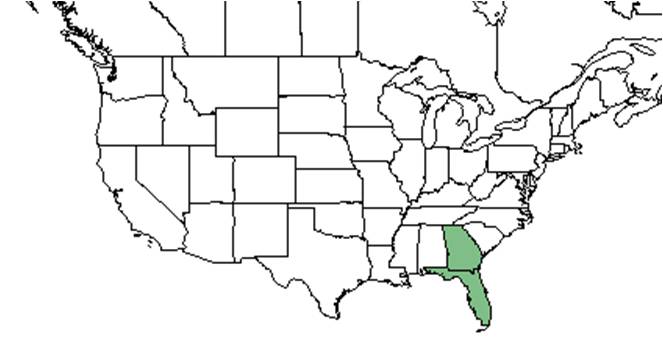Asimina reticulata
| Asimina reticulata | |
|---|---|

| |
| Photo by Wayne Matchett, SpaceCoastWildflowers.com | |
| Scientific classification | |
| Kingdom: | Plantae |
| Division: | Magnoliophyta - Flowering plants |
| Class: | Magnoliopsida - Dicotyledons |
| Order: | Magnoliales |
| Family: | Annonaceae |
| Genus: | Asimina |
| Species: | A. reticulata |
| Binomial name | |
| Asimina reticulata Shuttlw. ex Chapm. | |

| |
| Natural range of Asimina reticulata from USDA NRCS Plants Database. | |
Common name: Netted pawpaw
Contents
Taxonomic notes
Synonyms: Pityothamnus reticulatus (Shuttleworth ex Chapman) Small; Asimina cuneata Shuttleworth ex A. Gray.[1]
Varieties: none.[1]
Description
A description of Asimina reticulata is provided in The Flora of North America.
Asimina reticulata is a long-lived perennial that reaches 2 - 4 feet in height,[2] possesses leaves that are simple and alternate[3] with net like veins,[4] and has a rusty orange pubescent.[5]
Distribution
Ecology
Habitat
Asimina reticulata occurs in poorly drained sands of areas such as slash pine and longleaf pine-saw palmetto flatwoods, and is often abundant enough to be classified as an understory dominant.[5] Associated species include Quercus, Pinus, Serenoa repens, Lyonia lucida, L. ferruginea, and Befaria racemosa.[6][5] It has been observed to grow in full sun to partial shade.[7]
The range of A. reticulata and A. speciosa overlaps in the northern Florida peninsula, however they tend to occur in different habitats. A. reticulata is found in poorly drained low pinelands while A. speciosa is found on longleaf pine-turkey oak ridges in well drained sand.[5]
Asimina reticulata is an indicator species for the Central Florida Flatwoods/Prairies community type as described in Carr et al. (2010).[8]
Phenology
It blooms January through December.[3] Flower buds develop as an axillary growth on the new shoot growth of one season and flower the following spring after overwintering.[5] The hairy, ovoid buds develop as axillary growths on the new shoot growth and flower the following spring.[5]
Fire ecology
Following a disturbance such as fire or cutting, A. reticulata will immediately respond by putting up several leafy shoots with forming flower buds that will not open until the following growing season.[5]
Herbivory and toxicology
Asimina reticulata was observed at the Archbold Biological Station to host sweat bees such as Lasioglossum nymphalis (family Halictidae), leafcutting bees such as Megachile brevis pseudobrevis (family Megachilidae), and wasps such as Polistes dorsalis hunteri (family Vespidae).[9]
Diseases and parasites
A. reticulata is at risk to develop leaf blotch and eye spot.[10]
Conservation, cultivation, and restoration
Cultural use
The fruit of A. triloba is known to be sweet and custard-like. It was often used in baking, pie filling, or eaten raw. The fruits fall from the tree early and must be harvested from the ground to ripen later.[11] For medicinal purposes, the seeds can be used to induce vomiting or to treat head lice when powdered, and the fruit juice can be a treatment for intestinal worms.[12] Caution should be exercised though, as some people exhibit an allergic reaction of dermatitis to the fruit.[13]
Photo Gallery
References and notes
- ↑ 1.0 1.1 Weakley, A.S. 2015. Flora of the southern and mid-atlantic states. Working Draft of 21 May 2015. University of North Carolina at Chapel Hill, Chapel Hill, North Carolina.
- ↑ [[1]]Florida Native Plant Society. Accessed: November 24, 2015.
- ↑ 3.0 3.1 [[2]]Accessed: November 24, 2015. Lady Bird Johnson Wildflower Center
- ↑ [[3]]Eat the Weeds. Accessed November 24, 2015.
- ↑ 5.0 5.1 5.2 5.3 5.4 5.5 5.6 Kral, Robert. 1960. A Revision of Asimina and Deeringothamnus (Annonaceae). Brittonia 12:233-278.
- ↑ Florida State University Robert K. Godfrey Herbarium database. URL: http://herbarium.bio.fsu.edu. Last accessed: October 2015. Collectors: K.M. Meyer, A. Townesmith. States and Counties: Florida: Marion. Compiled by Tall Timbers Research Station and Land Conservancy.
- ↑ [Dave's Garden]Accessed November 24, 2015
- ↑ Carr, S.C., K.M. Robertson, and R.K. Peet. 2010. A vegetation classification of fire-dependent pinelands of Florida. Castanea 75:153-189.
- ↑ Deyrup, M.A. 2015. Database of observations of Hymenoptera visitations to flowers of plants on Archbold Biological Station, Florida, USA.
- ↑ [Garden Geeks] Accessed November 24, 2015
- ↑ Fernald, et al. 1958. Edible Plants of Eastern North America. Harper and Row Publishers, New York.
- ↑ Korchmal, Arnold & Connie. 1973. A Guide to the Medicinal Plants of the United States. The New York Times Book Company, New York.
- ↑ Burrows, G.E., Tyrl, R.J. 2001. Toxic Plants of North America. Iowa State Press.